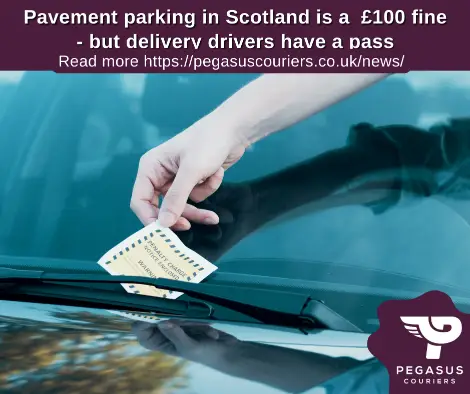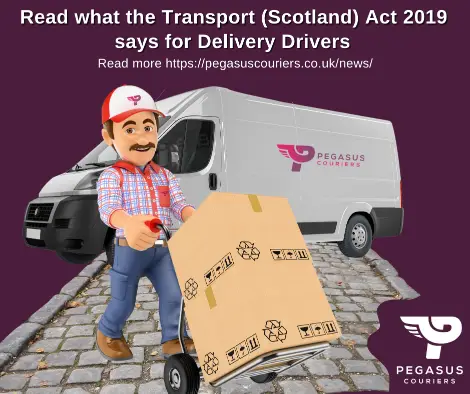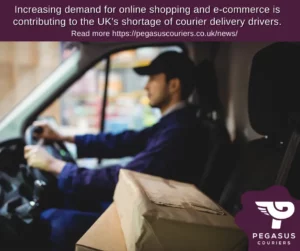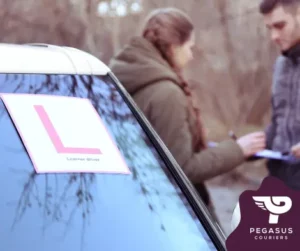Self-Employed Courier Insurance Cost If you’re thinking about self-employed courier insurance, it’s crucial to remember that this type of insurance is...
More HereBan On Pavement Parking: What Delivery Drivers Need To Know

If you are a delivery driver in Scotland, busy with the daily hustle of dropping off parcels, keep an eye on the upcoming changes. Starting in January, parking on the pavement could cost you a £100 fine. However, delivery drivers have been given an exemption within the parameters.
As you make your way through the city, keep in mind that the new parking ban aims to clear the walkways and make them safer and more accessible for pedestrians.
Clearer streets for a safer beat—that is the promise Scotland is making to its pedestrians.
What The Law Says: Impacts on Delivery Operations for Couriers
The new rules state that you can only park on pavements for up to 20 minutes while making deliveries or picking up packages. This regulation aims to reduce congestion and increase safety but can make finding a parking spot tough, potentially delaying deliveries for businesses that count on fast service.
Violating these parking regulations will hit your wallet hard due to steep fines. However, there is a bit of good news: you’re still allowed to park during active loading and unloading, which gives you some breathing room. To keep up with your delivery schedule and dodge penalties, you will need to investigate other parking options. It is more than just a suggestion; knowing these regulations inside out is key for a smooth operation.
Staying informed and adaptable is the backbone of efficient delivery services.
The Parking Ban Explained
As a delivery driver in Scotland, it is essential to stay informed about the latest pavement parking rules. With the new ban in place, parking on the pavement could cost you a £100 fine; reduced to £50 if paid within 14 days. This change requires finding other parking options to keep your deliveries on schedule.
Many delivery companies are already on board with these new rules. They recognise the importance of keeping streets clear and accessible, particularly for individuals with disabilities. Adapting to these changes may require some effort, but doing so helps ensure deliveries run smoothly and pedestrians can move safely through the city.
Adapting to change isn’t just about avoiding fines; it’s about contributing to a community where safety and accessibility are prioritised for the benefit of all.
Transport (Scotland) Act 2019 section 55 (6) titled Exceptions to pavement parking prohibition and double-parking prohibition states:
The pavement parking prohibition and the double-parking prohibition do not apply where—
(a)the motor vehicle is, in the course of business—
(i)being used for the purpose of delivering goods to, or collecting goods from, any premises, or
(ii)being loaded from or unloaded to any premises,
(b)the delivery, collection, loading or unloading cannot reasonably be carried out without the vehicle being parked on a pavement or, as the case may be, as mentioned in section 54(1),
(c)no part of the vehicle is within 1.5 metres of the pavement edge which is furthest away from the centre of the carriageway (however that edge is bounded),
(d)the vehicle is so parked for no longer than is necessary for the delivery, collection, loading or unloading and in any event for no more than a continuous period of 20 minutes.
The General Feeling About Pavement Parking
Delivery drivers are the lifeblood of urban commerce, and finding the right spot is part of the job. It’s about balancing speed with safety and legality.
The public’s support for tougher pavement parking laws is clear, with many people agreeing that sidewalks need to be safe and free from obstructions.
As someone involved in delivery work, you’re probably thinking about how these changes will affect your job, especially since there won’t be more parking enforcement staff. Concerns are rising about how deliveries will be handled, but there are some exceptions in place for drivers, showing an effort to maintain a balance between keeping walkways clear for pedestrians and keeping goods moving.
Groups that support the rights of disabled individuals are also in favour of the ban, arguing for barrier-free access.
Additionally, you may be wondering how the change will influence traffic as drivers look for permitted parking spaces and get used to the new rules.

Pedestrians and safe streets - a responsibility we all share.
The new regulations are more than just potential fines—they’re about ensuring that everyone has clear paths to walk on. A survey shows that a vast majority of pedestrians wanted the law for basic safety reasons.
For delivery drivers, the ability to park without getting a ticket is vital to keep timely deliveries while also contributing to less-crowded streets. It may take some time to get used to parking further from sidewalks, but such efforts help make the streets more accessible and easier to navigate for everyone.
A clear path for pedestrians and safe streets is a responsibility we all share.
Being a delivery driver involves more than just getting from point A to point B. It’s about understanding and respecting the community by following the rules and making sure our streets are safe and accessible for all.
Safety: Roads, Pavements and the Implementation
For those in the delivery business, being able to park without penalty is crucial for keeping deliveries on track while also making sure that streets are less cluttered.
It might require a bit of adjustment to start parking away from curbs, but doing so contributes to creating accessible and easy-to-navigate streets for everyone.
The new rules aren’t just about fines, they’re about making sure sidewalks are open for use. A significant number of walkers, 84% to be exact, feel that the streets will be safer.
While I am sure the greater community is all for changes relating to road and pavement safety – we will need to see how these plans will impact certain areas. I know for a fact that some roads are unusable if vehicles do not pavement park!
As a leader in the courier industry and an advocate for road and pedestrian safety – we support any initiative that saves lives… The argument would be, is a blanket implementation the way to go?
We will be watching how this unfolds.
Pavement Parking Frequently Asked Questions
Are There Time Restrictions on How Long a Delivery Vehicle Can Occupy Pavement Space Under the Exemption?
Parking rules for delivery vehicles can vary from one place to another. According to the Transport (Scotland) Act 2019 section 55 (6)(d) states: the vehicle is so parked for no longer than is necessary for the delivery, collection, loading or unloading and in any event for no more than a continuous period of 20 minutes. However, check local regulations as well as some streets could be exempt from the rule.
What Specific Criteria Must a Delivery Driver Meet to Qualify for the Pavement Parking Exemption?
To qualify for the pavement parking exemption as a delivery driver, you must apply at your local council, which provides specific requirements that take into account both local laws and the need to maintain accessible pathways for everyone. Staying informed on the latest regulations is key to avoiding penalties and contributing to the safety and accessibility of our streets. Vehicles such as emergency vehicles are exempt.
Will There Be Designated Areas for Delivery Drivers to Park on Pavements, or Is It up to the Driver's Discretion?
In the busy streets of the city, finding a parking spot is often a puzzle, especially for delivery drivers. The local laws don't set aside special areas for quick stops, so it's up to the driver to find a safe and legal place to park. It's essential to consider both the need to deliver efficiently and the necessity to follow traffic regulations. The act also states: "No part of the vehicle is (parked) within 1.5 metres of the pavement edge which is furthest away from the centre of the carriageway (however that edge is bounded."
How Will the Exemption for Delivery Drivers Be Monitored and Enforced to Prevent Abuse of the Privilege?
Monitoring and enforcing the exemption for delivery drivers requires careful oversight to ensure the system isn't misused. Authorities have yet to say how this will be monitored or controlled. It is possible that technology, such as cameras, will be used – however, nothing has been mentioned about this.
FOLLOW US TO KEEP UP TO DATE:
Best way to send a parcel UK
How to Send a Parcel In The UK: What You Need To Know Sending a parcel involves more than just boxing...
More HereUnlock Efficiency: Expert Courier Tips for Faster Parcel Delivery
UK Courier Service: Strategies to be the best Parcel Delivery Service Expert Courier Tips for Efficient Parcel Delivery Mastering UK courier...
More HereDriver Theory Test Cheats Impact All Road Users
Will Learner Driver Test Cheating Impact Businesses – Eventually? There is a Worrying Increase In Test Cheating Driver theory test cheating...
More Here


